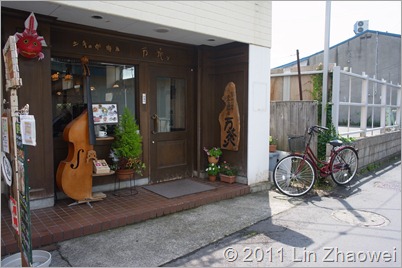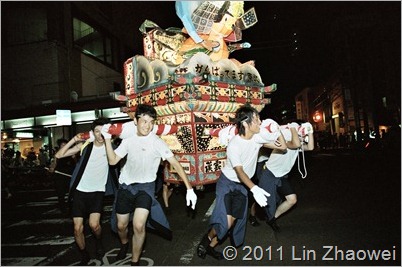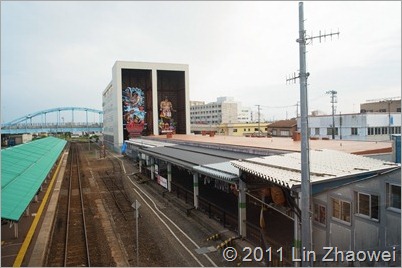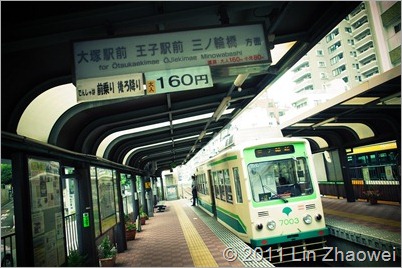Having featured an old cafe here and a few other interesting shops here, I have come to the last post on Hirosaki town, in Japan’s Aomori prefecture.
A few other shots from around town.
 |
| A beauty salon in Dotemachi. |
Having featured an old cafe here and a few other interesting shops here, I have come to the last post on Hirosaki town, in Japan’s Aomori prefecture.
A few other shots from around town.
 |
| A beauty salon in Dotemachi. |
The retail outlook in Hirosaki probably isn’t the brightest in Aomori prefecture. As Mr Kozai from Manchan told me, one of the biggest departmental stores in town, Nakasan, had just gone bankrupt. And as a result, those who have been accumulating vouchers from the store have essentially lost a substantial part of their savings.
And truth be told, when Joanne and I arrived in Hirosaki on Aug 1, the reception was rather cold. In the sense that as we dragged our luggage from the JR Hirosaki station to Super Hotel Hirosaki where we stayed, the streets were mostly empty, and not many shops seemed to be open. (The hotel was good btw)
But as it turns out, there are some interesting shops around, and we could have easily spent more time just browsing about town.
 |
| Display in men’s boutique The Screw, located just a stone’s throw away from our hotel. |
Last year, I first read about the town of Hirosaki (弘前) when I was preparing for my autumn trip to Aomori prefecture. It was simply a transit point for me, a place to take a break before I took the Resort Shirakami (リゾートしらかみ) train down Aomori’s scenic west coast for the final leg of that Aomori expedition. As a result, Joanne and I spent just a day there – which we realised was not enough!
As fate has it, we were “forced” to return to Hirosaki again this time, because all the hotels in Aomori city were fully booked, and Hirosaki is the nearest town with accommodation. And because we stayed there for four nights, there was plenty of time to explore the charming town a little more.
 |
| Manchan’s distinctive western style shop front. |
I would like to introduce some interesting shops I discovered during this trip, because yes, Hirosaki has more than just apples and the Neputa summer festival.
First up: Manchan cafe (万茶ン), said to be the oldest coffee house in the whole of Tohoku region and the fourth oldest in Japan
Because I decided on my trip just over a month before the summer festivals, I ended up staying at Hirosaki (弘前) town, even though my main purpose was to attend the Aomori Nebuta Matsuri (青森ねぶた祭り). All the Aomori hotel rooms on Rakuten Travel were fully booked by the time I checked!
Well in any case, since we were in Hirosaki, I thought I might as well visit the local Neputa matsuri (ねぷた祭り), which started on Aug 1, the day we arrived there.
While it was of a much smaller scale than its neighbouring town’s event, I was very happy to have been a part of the Neputa because it was 1) a good chance to test the exposure settings for my F6 (important as film is so expensive!) and 2) to see how a float-based matsuri like the Nebuta flows.
 |
| Local youths running on the street with their float. As part of their manoeuvres, some of the carriers would raise up their floats, run towards the audience, and stop just in the nick of time, a step or two in front of the seated audience. This I believe to show their strength in manoeuvring their heavy loads. (Nikon F6 with AFS 24/1.4, Fujifilm Natura 1600 film) |
Here’s a video I took of the grand finale at the Goshogarawa (五所川原) summer fireworks festival in northern Aomori prefecture, Japan. It was held on August 3.
The whole programme lasted about one and a half hours, and Joanne and I both enjoyed ourselves – after we managed to find a spot to sit and watch, that is. According to official estimates, about 280,000 people were there that evening.
The fireworks was part of the city’s summer festival, known as the Tachinebuta matsuri (立佞武多祭り). Like Aomori prefecture’s two other major summer festivals, it features a parade of floats in the city centre, accompanied by song and dance. Despite its relatively small scale – with only about 15 floats – the Tachinebuta literally stands out because it features three that stand at over 20 metres. That’s about 7 storeys high!
 |
| Two of the three tachinebuta that are featured in this year’s event. Taken from an overhead walkway at JR Goshogawara station. As you see, the floats tower over everything but the shed they are stored in. |
Unfortunately, we weren’t able to attend the festival, which started on the following day, as we had only four evenings to spare in Aomori prefecture. Two evenings were spent in Aomori city for the Nebuta matsuri (the biggest in the prefecture), and another in Hirosaki for the Neputa matsuri.
More to come on the Nebuta and Neputa festivals... :)
Tokyo is known for its complex train network, with 13 subway lines and two major railway lines serving the city centre. Just like any other new visitor to the city, I was overwhelmed when I first took a look at the train map back in 2007, when I was about to leave for my exchange in Japan.
In the smaller Japanese cities, however, residents are served mostly by buses, and some like Hiroshima and Okayama (which I have been to) have tram lines serving the city centre.
Many public bus services still run through Tokyo – I commuted by bus to my train station almost every day when I went to school there. They charge a flat rate of 200 yen and are incredibly punctual. (I believe it’s partly to do with good planning and a general lack of traffic on the bus routes.)
But did you know that there are still trams in Tokyo?
One of them is the Arakawa line, which opened in 1913 and now serves a few suburbs just north of the JR Yamanote line.
Last week, on the second day of my holiday in Japan, Joanne and I took the Arakawa line from one end (Waseda) to the other (Minowabashi). Earlier in the day, I’d brought Joanne on a tour of the Nishiwaseda campus where I’d studied, so actually it was a no-brainer to finally take the chance to explore the line.
 |
| Ready to board the tram at Waseda station? It’s located just behind the Nishiwaseda campus library. All adult passengers pay a flat fare of 160 yen, regardless of how far you go. The trams are also fairly regular, with a frequency of about 8 minutes in the afternoon. It got surprisingly packed after just a few stops though! |